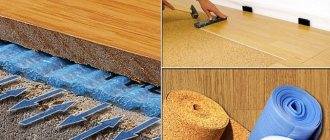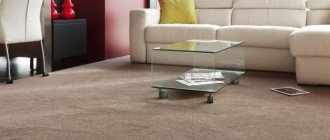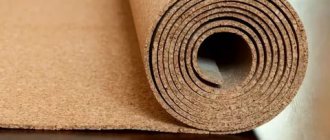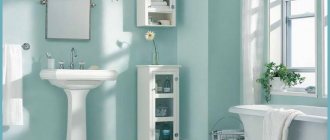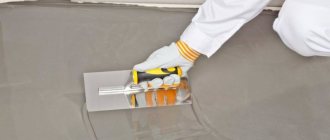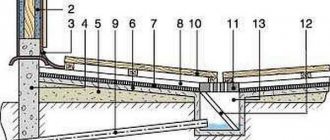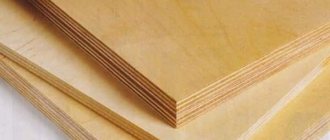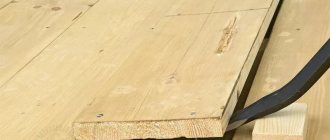What is a substrate
Laminate flooring should not be laid on bare floors. Even the smallest gaps may appear between the board and the floor. As a result, the laminate will bend, the bottom ball of the coating will suffer and, as a result, moisture will get there and the material will be deformed.
A substrate (adregent) is needed because it:
- protects against moisture;
- Well isolates otherworldly noise;
- can smooth out some floor defects.
We must not forget that laminate flooring is covered with paper, and the base underneath can be greatly damaged by possible moisture. This is where the moisture-absorbing properties of the substrate come in handy. This material will also help to minimize the sound of walking, while at the same time protecting against possible noise from neighboring apartments.
What is the choice based on?
The most important parameters: the type of material, as well as the thickness of the substrate under the laminate. The quality of the product often affects the service life. Therefore, the substrate for the laminate is selected taking into account the manufacturer.
Thickness
The recommended value is no more than 3 mm. The fact is that the floor is constantly exposed to loads of different nature and varying intensity. For example, if a decorative floor covering with a significant protective layer is impacted pointwise, there is a high risk that the laminated coating will become deformed. Therefore, it is recommended to select substrates for laminate based on this property.
The thickness of the substrate should not exceed 4 mm, it is excellent if it is 2 - 3 mm.
Another risk factor is premature failure of the coating locks. This is usually a consequence of the material regularly bending when walking. All these processes will be accompanied by an unpleasant squeak, which even a backing to protect the laminate made of such a reliable material as expanded polystyrene/extruded polystyrene cannot save from.
Review of brands, products
Good options: underlay for laminate Axton, Izoplat, Teplon, Arbiton, Tuplex, Izolon, Isopolin, Parkolag, Plenex, Cork. The last of the options mentioned is a cork backing for the laminate. Plenex is the most affordable type of protection. The required qualities are achieved thanks to manufacturing technology - extruded polyethylene.
Plenex is still used along with more effective interlayers (expanded polystyrene/polystyrene, material with foil), as it provides hydro- and thermal insulation.
Parkolag backing: A layer of crumbs made from pieces of cork is applied on top, sold in the form of rolls, folded inside out.
The underlay for laminate protection from the manufacturer Izoplat is a completely safe option. It is made from pine wood. Accordingly, Izoplat is a coniferous substrate for laminate. This option is not elastic. And the minimum thickness of the Isoplat plate is 5 mm. The Arbiton analogue belongs to the group of professional products. Foamed polystyrene is used to make it.
Izolon is a backing for laminate, equipped with foil. This option, in addition to the basic properties that foam polyethylene is characterized by, is also distinguished by its vapor barrier properties. But the substrate for laying the Teplon laminate is a sheet material, polystyrene is used in its manufacture.
The analogue of Tuplex and Parkolag are produced using different technologies: in the first case, the main material is polyethylene, in the second - cork chips . But these options are similar in properties: the substrate under the laminate provides heat, sound and vapor insulation. Among the variety of designs, there is also a protective accordion layer. From the name you can guess what form of release the product is. But this option is less popular today.
Price-quality ratio
The cost can vary greatly: from 14 to 145 rubles/sq.m. m. At the same time, the price is influenced by the quality of the coating, which consists of the degree of reliability of the material, its hygroscopicity, as well as heat and vapor barrier qualities.
When deciding how to choose a subfloor for laminate flooring, service life is also taken into account. At the same time, a well-known brand does not always guarantee long-term operation. To determine how long a laminate flooring protection underlay will last, you need to rely on the type of material.
Kinds
Now there is a very large selection of different types of substrates on the market. The most popular coatings remain:
- natural cork;
- polystyrene;
- polyethylene - isolon;
- thermal insulating wood boards.
Cork lining has excellent soundproofing properties. It also protects well from excessive heat.
There are several types of cork substrate:
- from cork chips
- pressed cork sheet
- rubber-cork;
- bitumen-cork.
A product made from wood of the same name almost never sags. This is really important, as sagging underlayment increases pressure on the locks of the laminated boards. In addition, cork is an environmentally friendly material that is perfect for a child’s room or bedroom. In addition, this coating has a very long service life. You should not skimp on cork; low-quality material will quickly begin to crumble.
Cork lining can be purchased in rolls and slabs.
Cork also has two disadvantages:
- relative high cost;
- low moisture resistance. Therefore, it is always recommended to place a plastic film under such a substrate for vapor barrier.
Polystyrene is ideal in terms of price-quality ratio. This material is produced in the form of slabs measuring one meter by one meter. Foamed polystyrene has a long service life, in addition, it can easily withstand heavy loads. Plates 3 mm thick can provide ideal sound and thermal insulation.
Izolon is the cheapest material from which laminate substrates are made. This foamed polyethylene with a thickness of 2-3 mm is produced in the form of rolls. It is very easy to install, and the joints are connected with ordinary tape. There is also a type of isolon that is covered with aluminum foil, which provides excellent thermal insulation. This material also acts as a vapor barrier for a concrete floor, which prevents the appearance of fungi.
The main disadvantages of isolon:
- since the material is quite thin and porous, it quickly deforms;
- under mechanical loads, polyethylene breaks easily;
- poor sound insulation.
Wood panels are made from various kinds of woodworking residues on sawmills. This agent protects well from extraneous noise. In addition, it retains heat perfectly. The lining is made in the form of green slabs. The main disadvantages of this coating:
- high price;
- the need to do a vapor barrier before installation.
In addition to the above-mentioned substrates, there are several more options:
- Coniferous products are similar in their properties to cork, and although they are not so flexible, they allow air to pass through perfectly, that is, they can “breathe”.
- Foil lining creates the effect of a thermos in the room. Single- and double-sided material is available for sale.
- There are integrated backings that are glued directly to the laminate. Rubber is often used for this. The downside is that this laminate is quite expensive.
Choosing a lining layer option
What type of underlay can be laid on a concrete floor? Several types of material can be used.
Izolon
This is the most popular type of substrate; it is made of polyethylene foam. Produced in the form of rolls, the recommended thickness of isolon is 2-3 mm.
Advice! There is a polyethylene backing on sale with a thickness of 4 millimeters or more, but these material options are not suitable for laying under laminate.
Advantages:
- moisture resistance, the material provides excellent protection against moisture;
- inertness, the material, although of artificial origin, does not emit any toxic substances;
- affordable price, this is the cheapest type of substrate;
- Resistant to mold and other biological hazards, it is not affected by insects and rodents.
Flaws:
- under significant loads it quickly sags and no longer regains its shape;
- does not have good soundproofing properties (only dampens impact noise).
Advice! There is a variety of isolon on sale, supplemented with a layer of foil. This material option is a good heat insulator.
Expanded polystyrene
This is a new generation material, characterized by high levels of sound and heat insulation. In addition, expanded polystyrene is more resistant to stress, so it can be used in rooms with high traffic. Advantages:
- high strength indicators even when exposed to significant loads;
- chemical inertness;
- moisture resistance.
The disadvantages of the material include:
- poor ability to level the subfloor;
- the material is produced in sheets, so when laying there is more waste than when using rolled materials.
Technical traffic jam
Natural cork is an excellent lining option for laminate flooring. The material is produced in sheets and rolls. Technical cork comes in different thicknesses, but for laminate flooring it is recommended to choose a material with a thickness of 2-3 mm. Advantages:
- environmental Safety;
- excellent heat and sound insulation;
- ability to maintain shape even under significant loads;
- resistance to mold formation.
Minuses:
- high price;
- low resistance to moisture;
- It is not suitable for installing a heated floor system because it is a very good heat insulator.
So, if you plan to lay laminate on a concrete floor, then the use of an underlay is mandatory. The correct choice of underlayment will extend the service life of the coating. You can lay different types of underlay on a concrete floor, but when choosing an option, you need to consider the advantages and disadvantages of each option.
Substrate properties
As already noted, the main properties of the substrate are: moisture and sound insulation. In addition, the substrate is also an excellent insulation material. It should also be noted the shock-absorbing properties of the adregent, because it softens impacts and contact of the laminate with the floor.
Each type of lining has its own advantages. For example, isolon:
- chemically neutral base;
- ideal for laying on a concrete base;
- not susceptible to fungi and mold;
- moisture resistant and durable.
The good old traffic jam is good because:
- does not compress;
- resistant to fungi and parasites;
- has a long service life.
Overview of the main varieties
Having understood the functions of the protective layer, you can move on to the next stage, when the question of which substrate is better is decided. There are different options: from cork, polymers (polystyrene, expanded polystyrene, etc.), foil version and even coniferous version. In addition, there are also combined types of laminate substrates.
Types of cork coverings
The main advantage is environmental friendliness. You can use such a coating even in a child’s room without fear of harming a fragile body. Other advantages: wear resistance, excellent shock absorption, leveling and sound insulation properties.
Be careful when choosing a cork backing: if you get a low-quality and cheap one, it will crumble.
The underlay for laying cork laminate comes in different types:
- Canvas;
- Crumb products;
- With the addition of bitumen;
- Rubber cork option.
But if you use a low-quality protective layer, then there is a possibility of cracking of the material, which will lead to the creaking of the decorative coating. This laminate underlay does not provide complete protection from moisture, but is quite expensive.
Foamed polypropylene
This is a wear-resistant material that can be used even on a not very flat floor surface with significant differences in levels. At the same time, regular friction will not affect the quality of the substrate under the laminate. But the soundproofing qualities of the material are low, and in addition to this, restrictions on operation should also be noted.
foamed polyethylene (also known as polyethylene foam or closed-cell polyethylene) is the most affordable option;
In particular, it is not recommended to lay a polypropylene layer where heavy loads are placed on the floor. But for an apartment this is an ideal option, which is quite suitable for a concrete base.
Features of expanded polystyrene
This laminate underlay is characterized by increased strength, which means it will withstand considerable loads placed on the floor. Other advantages: excellent sound and heat insulation. However, expanded polystyrene has a serious drawback - susceptibility to fire.
Such a substrate is not damaged by insects and rodents, and bacteria and fungi do not multiply in it.
In addition to this, the substrate under the laminate made of this material emits harmful substances during the combustion process. And expanded polystyrene has a relatively short lifespan (6-7 years), especially where the floor is subject to increased loads.
Products made from pine needles
This is an environmentally friendly, breathable material made from cellulose. The sheet backing for the laminate in this design is not particularly rigid, which is why this particular form of release was chosen.
Its price is slightly higher than other analogues, but this substrate is positioned as a high-quality and durable material.
Given these properties, it is recommended to lay the material on a fairly level floor. The coniferous backing for the laminate can be placed on a rough base with a difference in levels of no more than 2 mm for every 2 square meters. m.
The main disadvantage that characterizes the coniferous underlay for laminate flooring is that its height varies between 4 and 7 mm, which exceeds the maximum permissible thickness of the protective layer.
Foil protection
The backing for this type of laminate is found in two versions: foil on one side and on both sides. The quality of protection in the second case will be higher, but both options provide a “thermos” effect. For this purpose, it is recommended to use tape with foil to attach the strips. When laid on the floor, such a layer will provide sound and heat insulation.
It is easily and quickly laid on the base; this material is often used to create heated floors
Polyethylene film
If we compare this option and expanded polystyrene/extruded polystyrene, its service life is much shorter - no more than 3 years. The sufficient thickness of the substrate for the laminate in this case is 0.2 mm. But if extruded polystyrene/expanded polystyrene and cork are laid end-to-end, then the substrate under the polyethylene laminate must be laid with an overlap.
Combined, integrated protection
There are also designs made from different materials, for example, a layer in the manufacture of which polyethylene and expanded polystyrene are used. In this case, the substrate to protect the laminate acquires other properties: sound and waterproofing are added. You can use simpler analogues as opposed to existing varieties. In particular, some users place cork material on the floor, which is used in the manufacture of cup holders.
Rubber backings are integrated materials, that is, they are immediately glued to the laminate at the production stage.
There is a more convenient option - a substrate for the laminate, which is called integrated. This means that the protective material is already included in the laminated covering. Moreover, the substrate for laying the laminate in this case is a layer of rubber glued to the decorative coating. This option significantly saves time during installation.
How to install laminate flooring on a concrete floor
- First, prepare the concrete floor surface; if there are large unevennesses, they are corrected.
- It is important that the materials from which the installation will be carried out lie in the room for at least 2 days. Thus, the laminate will adapt to the temperature and humidity of the room.
- It is recommended to prime the floor before laying it.
- After this, a waterproofing film is laid on the floor with a margin of 20-30 cm. The joints are filled with tape.
- Then the lining is laid. It’s better not to do it all at once, but as you lay the laminate. The edges of the substrate should be 2-3 cm on the walls.
- Installation of laminated boards begins from a source of natural light, that is, from a window.
- When laying elements, pegs are placed between them and the wall. It is important to correctly connect all the elements of the laminate to each other. The slats are mounted one after another at a slight angle and without much effort.
- To ensure that the rows fit together well, you can tap a wooden block and hit it with a hammer. In this way, the entire floor space is filled.
- Almost always in the premises there are heating pipes, various communications, etc., which do not allow the normal installation of part of the laminate. Therefore, to cut out shaped elements you will have to use a jigsaw and a construction knife.
- The process of installing laminate boards ends with laying the baseboards.
How to style
Having found out what is placed under the laminate on different types of flooring, I want to share my experience in laying the material. We used 2 types of substrate - foamed polypropylene on a concrete base and pine substrate on a wooden one.
On wooden floors
Before laying the covering, we inspected the old plank floor. It was replaced a few years ago, but it needed some work. The whole process goes like this:
- Inspect every square meter of the foundation. Check it for chips, cracks and unevenness.
- Eliminate all defects: clean out the bumps and holes, coat the base with a special antifungal compound. Wait until completely dry.
- Level the floor with plywood if necessary. We had to additionally level the space for better laying of the laminate. We secured the sheets of plywood with self-tapping screws, the distance between the fasteners was 10 cm. The joints near the walls were puttied and sanded, having previously removed all the old baseboards. Before finishing we used a hand scraper.
- When installing the underlay on wooden floors, do not use steam or waterproofing - this will interfere with normal ventilation.
- Unpack the substrate and leave for 24 hours to reach room temperature.
- It is correct to start laying the material from the corner, placing it in a herringbone pattern at an angle of 45 degrees.
- Use a utility knife for cutting.
Interesting article on the topic: How and what is the best way to level a floor under a laminate
When subsequently laying the laminate, the seams of the substrate should not coincide with the seams of the finishing.
On concrete bases
For the concrete floor, we used the classic version of the substrate - foamed polypropylene. It is sold in large wide rolls. We chose the option with a thickness of 5 mm. The process looks like this:
- Wait until the roll coating reaches room temperature.
- Treat the concrete base: eliminate all defects, fill holes with mortar. If a self-leveling floor is used, there should be no cracks.
- Spread the underlay on the floor perpendicular to the future laying of the laminate.
- Bend the material slightly towards the walls by 10-15 cm. If necessary, secure with tape.
- The substrate is not fixed in any way to the concrete base. It can be laid joint to joint with a slight overlap, which will not affect the thickness of the coating in any way.
- It does not matter which side the polypropylene foam is placed on.
- After spreading the material over the entire surface, proceed to laying the laminate.
Try to follow all recommendations and technological instructions when working with raw materials. When laying laminate flooring, do not allow gaps to form in the seams - this will lead to further damage to the integrity of the coating.
Viewed times: 6,811
Great article 2
Author's rating
Author of the article
Oleg Grishin
Flooring specialist with 10 years of experience. Oleg has something to share with our readers
Articles written
105
- Even more interesting:
- Top Russian and European laminate manufacturers
- Types of vinyl laminate. Advantages and disadvantages
- Characteristics and installation of chamfered laminate
Substrate thickness
As for the thickness of the substrate, there are some nuances. There is an opinion that the thicker the base, the better. But it's not that simple. If you lay the lining in two balls or take a lining that is too thick, it may happen that it will compress under heavy weight. The result is deflection of the boards plus wear of the locks, after which a fairly loud sound will appear when walking on the laminate.
If the flooring is fairly level, experts advise using a thin adregent with a thickness of about 1.8-2 mm.
Tips and recommendations when choosing a substrate for laminate
Considering the number of manufacturers and types of substrates, it is worth understanding what to look for when choosing. Expert advice will help resolve this issue.
- It is better to choose environmentally friendly material because it does not have a negative impact on human health.
- If laminate flooring is installed in an individual house or on the first floor of a multi-storey building, then the issue of thermal insulation will be relevant. It is better to choose materials that do not transmit heat well.
- Sound insulation is another important parameter for residents of multi-storey buildings. Most manufacturers pay a lot of attention to it, but it is much lower for substrates made of natural materials.
- The thickness may vary because you need to get a perfectly flat surface. The standard thickness of the substrates is 3 mm.
These are the main parameters that you should pay attention to. They will help you choose the best quality substrate that will suit your needs and financial capabilities.
Expert opinion: Afanasyev E.V.
Chief editor of the Stroyday.ru project. Engineer.
I advise you to familiarize yourself with my material - which floor insulation to choose for concrete.
The manufacturers mentioned above are reliable. They have been working on the market for a long time and offer certified products with excellent characteristics. If you don’t want to spend a lot of time studying all the features of a particular brand, you should choose among those that are in this rating.
Video - How to choose a substrate for laminate: thickness, types, tips on selection and installation
Estimated cost
The cost of the substrate depends on the material, its thickness and manufacturer.
- The lowest in price are substrates made of polyethylene foam and polystyrene. Typically, the thickness of such a product is 1.5-3 mm, and the price is 30-120 rubles per square meter.
- Cork products will be more expensive; for a thickness of 2-3 mm you will have to pay 120-180 rubles per m2. Six-millimeter ones will already cost about 350-400 rubles. Rubber cork, which is produced mainly abroad, can cost from 1000 rubles/m2.
- Also, do not forget about coniferous linings, the cost of which is 100-150 rubles/m2.
So, high-quality installation of laminate directly depends on the choice of substrate, so this process should be taken really seriously.
Coniferous substrate
Coniferous substrate is called heat and sound insulating wood boards made from pressed waste from the wood processing industry. The most common thermal insulation board is Isoplat. Produced in the form of green sheets. The thickness is different, but, as a rule, varies from 4 to 10 cm. Laminate manufacturers do not recommend the use of thick substrates, therefore, complaints about the quality of the floor covering in the case of using thick Isoplat are not accepted. The cost of the material is high, comparable to the price of high-quality cork.
The advantage of this coating is its breathability; it is a breathable material made from environmentally friendly raw materials; it allows air to pass through but retains moisture. Due to the high hygroscopicity of the slab, a vapor barrier is required. Good leveling ability allows you to remove unevenness in the base with a depth of 2-3 mm. The damping qualities, resistance to static and shock loads, noise insulation properties and durability of Izoplata are excellent. In addition to the price and great thickness, Izoplat has one more weak side, and a very serious one. Manufacturers claim that the material is absolutely environmentally friendly, but when processing and further laying slabs with a loose structure, tiny particles of wood dust are released into the air, which can have an irritating effect on the respiratory system. After the work on laying the substrate is completed, it is necessary to thoroughly vacuum the entire room and carry out wet cleaning.
